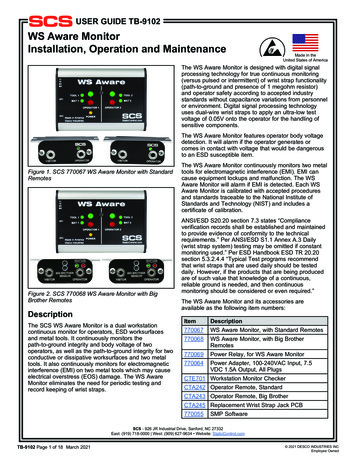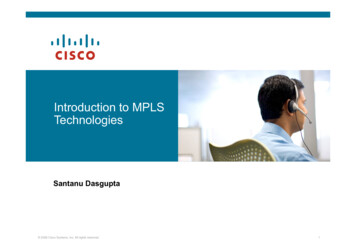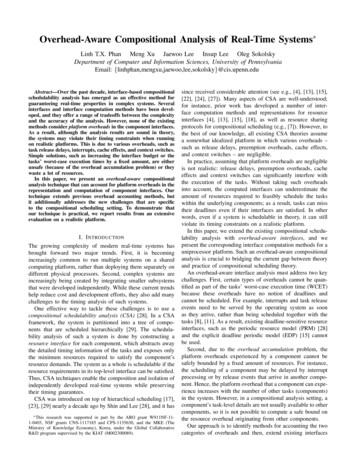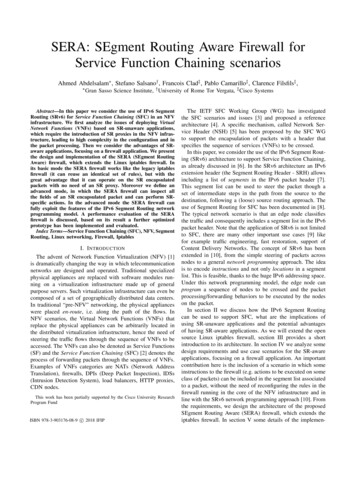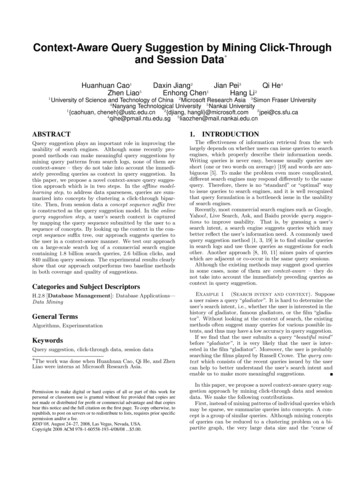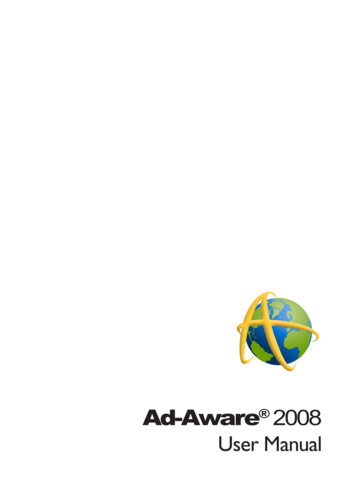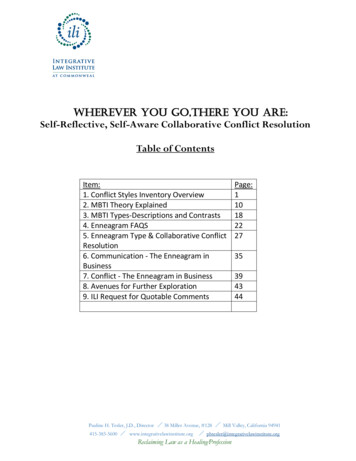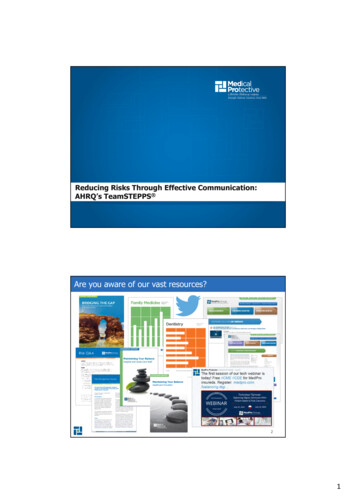
Transcription
Reducing Risks Through Effective Communication:AHRQ’s TeamSTEPPS Are you aware of our vast resources?21
Join Us on TwitterJoin us on Twitter @MedProProtector!Risk management and patient safety informationdelivered in a convenient, flexible formatArticlesToolsAnnouncementsCase studiesResourcesRisk Q&AVideosAnd more!Not on Twitter? Give It a Try!Twitter is an easy, quick way to staycurrent with healthcare news andtrends, receive information andresources, connect with individualsand organizations, and receive riskmanagement info from MedPro!Opening an account is simple —visit www.twitter.com.3ObjectivesAt the conclusion of this program, you should beable to: Identify the role of communication inhealthcare litigation. List three essential elements for makingTeamSTEPPS effective. Evaluate your organization’s likelihood ofeffectively implementing TeamSTEPPS.42
Registration polling resultsRegistration polling results will be sharedduring the live webinar.5Today’s programToday’s speaker is Christine M. Hoskin, RN, MS, CPHRM, SeniorPatient Safety & Risk, MedPro Group(Christine.Hoskin@medpro.com)Christine provides comprehensive risk management services to healthcaresystems, hospitals, clinics, and doctors in Colorado, Nebraska, Oklahoma,Iowa, and Kansas.Christine has been involved in risk and quality management throughout hercareer, providing oversight of clinical education, epidemiology, safety,accreditation, risk management, quality improvement, and nursing. Shehas experience in a range of care settings — including both inpatient andoutpatient facilities, primary care, specialty care, dental care, andrehabilitation — and with various patient populations.These opportunities have enabled Christine to develop a strong understanding of the challengesand opportunities facing healthcare providers and organizations.Christine is a registered nurse. She earned her bachelor of science and master of science degreesfrom Nebraska Methodist College of Nursing and Allied Health. Additionally, Christine is a member ofthe American Society for Healthcare Risk Management and holds a certificate in healthcare riskmanagement and completed the TeamSTEPPS master trainer curriculum.63
Today’s programToday’s speaker is MaryAnn Digman, RN, MSHA, Senior PatientSafety & Risk Consultant, MedPro Group(Maryann.Digman@medpro.com)MaryAnn brings a wealth of education and more than 25 years ofprogressive clinical and operational healthcare leadership experience toher responsibilities at MedPro Group.Her previous roles in large integrated systems, academic medicalcenters, community hospitals, and rural healthcare facilities in public,not-for-profit, and investor-owned systems — and her experience as aCOO/CEO ― are invaluable to her clients as they develop effectivebusiness strategies.MaryAnn earned her RN degree from St. Mary’s School of Nursing in Rochester, Minnesota. Shecompleted her bachelor of science degree in health education from the University of New Mexico andher master of science degree in healthcare administration from the University of St. Francis in Joliet,Illinois.MaryAnn is a member of the American College of Healthcare Executives (ACHE), and she has servedon the Board of Directors of the Voluntary Hospitals of America (VHA) Southwest, the New MexicoHospital Association, and numerous community agencies.7Patient safety movement“To ErrIs Human”IOM ReportDODMedTeams ED Study1995JCAHO NationalPatient SafetyGoals2001TeamSTEPPS Institute forHealthcareImprovement100K livesCampaignExecutivememo fromPresident1999TeamSTEPPSreleased to thepublic20032004Patient Safetyand QualityImprovementAct of 20052005TeamSTEPPSNationalImplementationProgram began2006 2007Centers forMedicare &Medicaid ServicesPartnership forPatients CampaignNationalImplementationof CUSP20082011Medical Team Training84
Why are we still talking about patient safety?9Communication as a risk factor by allegation category36% of all MedPro claims closed between 2005 and 2014 involve communication as a contributing factor.Of these, 59% were associated with outpatient settings, and 41% were associated with inpatient settings.Within the top 10 allegation categories, as shown here, patient monitoringcases had the highest percentage of communication issues identified(68%). These cases include allegations of inadequate monitoring ofpatient conditions/symptoms after treatments or procedures.Percentage of Allegation Categories WithCommunication Noted as a Contributing Factor80%70%68%60%50%40%50%NOTE: Communication is both an allegationcategory and a contributing factor.47%39%30%35%35%33%33%29%23%20%10%0%Source: MedPro Group closed claims, 2005-2014Date105
Communication as a risk factor by responsible serviceCommunication issues are a common theme across all provider types, withfamily/internal medicine cases accounting for the highest percentage.Percentage of Claims With Communication as aContributing Factor by Responsible Service18%16%15%ENT and plastic surgery account for half of the surgicalspecialties; cardiology and neurology account for almost half ofthe medicine %DateSource: MedPro Group closed claims, 2005-201411Communication as a risk factor by specific issuePercentage of Claims With Communication as aContributing Factor by Specific Communication Issue60%57%52%50%40%30%Communication factorsoccur almost evenlybetween providers andpatients/families and amongproviders. Technology issuesare beginning to make theirway into claims involvingcommunication as well.20%10%3%0%Communication betweenproviders andpatients/familiesCommunication amongprovidersSource: MedPro Group closed claims, emedicineDate126
Communication as a risk factor between providers & patients/families35%Percentage of Claims With Communication IssuesBetween Providers and Patients/Families31%Issues with informed consent and patient education,as well as poor rapport, drive communicationbreakdowns between providers and patients/families.30%25%23%23%Education (including dischargeinstructions)Poor rapport20%15%10%5%0%Inadequate informed consentDateSource: MedPro Group closed claims, 2005-201413Communication as a risk factor among providers90%82%Communication during handoffs, consults, andreferrals is a major driver in claims involvingcommunication issues among providers.Percentage of Claims WithCommunication Issues Among Providers80%70%60%50%40%30%20%13%10%3%0%Regarding patient’s conditionFailure to read medical recordSource: MedPro Group closed claims, 2005-2014Poor professionalrelationship/rapportDate147
It’s a problem — how do we fix it?Date15What does TeamSTEPPS stand andPatientSafety168
What is TeamSTEPPS?TeamSTEPPS is an evidence-basedteamwork system designed to optimizepatient outcomes by improvingcommunication and teamwork skillsamong healthcare professionals.The TeamSTEPPS framework andcompetencies are based on knowledge,attitudes, and performance.The program includes a comprehensiveset of ready-to-use materials and atraining curriculum to successfullyintegrate teamwork principles into anyhealthcare system.17Key principles of TeamSTEPPS189
Evidence that TeamSTEPPS worksCapella, et al. (2010) Trauma resuscitation teamimplementation Pre- and post-TeamSTEPPStraining results: Team performance improvedacross all teamwork skills:leadership, situationmonitoring, mutual support,communication Significantly decreased timesfrom arrival to CT scanner,endotracheal intubation, andoperating roomThomas & Galla (2013) System-wide implementation Pre- and post-TeamSTEPPStraining results: Significant improvementin HSOPSC scores on feedbackand communication abouterror, frequency of eventsreported, hospital handoffs andtransitions, and teamworkacross units Incremental changes evidentthrough reduction ofnosocomial infections, falls,birth trauma, and other incidentsMore success stories: tmCapella, J, et al. Teamwork training improves the clinical care of trauma patients . Journal of SurgicalEducation 2010 Nov-Dec;67(6):439-43.Thomas, L., Galla, C. Building a culture of safety through team training and engagement. PostgradMed Journal, 2013; 89:1053 394-401.19High-performing team?2010
Characteristics of high-performing teamsHigh-performing teams: Hold shared mental models Have clear roles and responsibilities Have clear, valued, and shared vision Optimize resources Have strong team leadership Engage in a regular discipline of feedback Develop a strong sense of collective trust and confidence Create mechanisms to cooperate and coordinate Manage and optimize performance outcomesBaker, D., Day, R, & Salas, E. Teamwork as an Essential Component of High Reliability Organizations. HealthServices Research. 2006 Aug; 41 (4Pt 2): 1576-1598.21How does TeamSTEPPS work?2211
ResourcesAssessmentTeam developmentLeadership engagementDefining the problemAction planning worksheetsCreating change teamsAnd the list goes on23Tools & strategies summaryBARRIERS Inconsistency in teammembership Lack of time Lack of information sharing Hierarchy Defensiveness Conventional thinking ComplacencyTOOLS/STRATEGIES Varying communication styles Lack of coordination andfollow-up with coworkersCommunication: SBAR, callout, check-back, handoff Leading teams: brief, huddle,debrief Distractions Conflict Fatigue Workload Misinterpretation of cues Lack of role clarity OUTCOMES Shared mental modelSituation monitoring: STEP,I’M SAFE Adaptability Team orientationMutual support: taskassistance, feedback, assertivestatement, two-challenge rule,CUS, DESC Script Mutual trust Team performance Patient safety!2412
Tools — communication25Communication — additional handoff tools Administrative data; new clinical information; tasksto be performed; illness severity; contingency plansfor changesANTICipateI PASSSHARQ Illness severity; patient summary; action list for thenew team; situation awareness and contingencyplans; synthesis and “read back” of the information Situation; history; assessment; recommendations/result; questions2613
Tools — leadership27Tools — situation monitoring2814
Tools — mutual support29Video vignettes Based on tools Variety of practicesettings Free Additional nstructor/videos/index.html3015
Program training options — AHRQ Train-the-trainer. This 2-day training course isdesigned to create a cadre of teamwork instructorswith the skills to train and coach other staff members. Fundamentals. This curriculum includes 4 6 hoursof interactive workshops for directpatient care providers. Essentials. This curriculum is a 1- to2-hour condensed version of theFundamentals Course and is specificallydesigned for nonclinical support staff. Online and in-person options areavailable.Register for free training or learn more: http://teamstepps.ahrq.gov/31Tailoring your program Limited English proficiency Dental Primary care Medical specialties Long-term care Rapid response CUSP toolkits CLABSI tools Chronic care Shared decision-making Rapid response systems3216
Medpro Group commitment33Recap of phases3417
Phase 1 Complete siteassessment evaluation Review data Provide feedback onworksheets/plans35Phase 2 Review action plan Review training plan Troubleshoot whencomplications occur3618
Phase 3 Review outcomes Recommendadjustments toaction plans37The real world — interview with a TeamSTEPPS facilityCASS COUNTY HEALTH SYSTEMAtlantic, IowaJennifer Arp, BSN, RN, CPHQPerformance Improvement DirectorQuality/Risk Mgmt./Safety/Infection ControlEmployee Health/Care Coordination3819
What questionsdo you have?39DisclaimerThe information contained herein and presented by thespeaker is based on sources believed to be accurate at thetime they were referenced. The speaker has made areasonable effort to ensure the accuracy of the informationpresented; however no warranty or representation is madeas to such accuracy. The speaker is not engaged inrendering legal or other professional services. If legaladvice or other expert legal assistance is required, theservices of an attorney or other competent legalprofessional should be sought.4020
among healthcare professionals. The TeamSTEPPS framework and competencies are based on knowledge, attitudes, and performance. The program includes a comprehensive set of ready-to-use materials and a training curriculum to successfully integrate teamwork principles into any healthcare system. 18 Key principles of TeamSTEPPS
